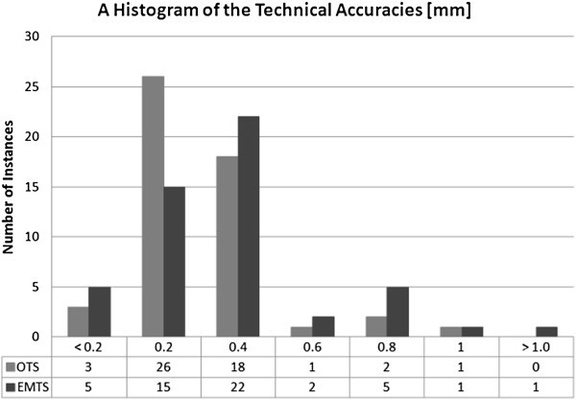EM versus optical tracking in neuronavigation
During neuronavigation, the 3D position and angle of the TMS coil, a digitizing stylus and the head of the patient typically must be known at all times. Position tracking can be performed either using optical tracking with large cameras, or electromagnetic (EM) tracking based on a DC pulsed magnetic field emitted by a small box. DC pulsed tracking as used by our system is very resilient against the presence of many nearby metals, such as copper, aluminium and stainless steel, unlike AC EM tracking. Both optical and EM tracking techniques have proven their value in neurosurgical navigators where they are equally popular, and proven equally accurate in larger studies (Koivukangas, 2013 and Ricci, 2008).
For the accuracy of stereotactic position measurements on the head, one should consider that the total deviation is dominated by spatial errors in the MRI segmentation of the skin and brain in the head model on the screen, the placement of markers on the head model, and the measurement of the head using a digitizing pen. The accuracy of the actual position measurement of the sensors, which is approximately one millimeter for both optical and EM tracking systems, only has a limited influence on overall navigation accuracy (see Neggers et al, 2004).
One of the main disadvantages of optical tracking is the so called ‘line-of-sight occlusion’, or the inability to track and navigate when the camera's view is blocked e.g. by the arm of a person using the equipment. This is known to be a real nuisance for optical navigation. Other disadvantages are the large camera stand and the smaller sensors.
On the contrary, the DC pulsed EM navigation which is used in our Neural Navigator has no ‘light of sight occlusion’ and only a small box, saving a lot of space. Of course a magnetic pulse generated by a TMS coil very briefly interferes with EM position tracking near the TMS coil, for about 1 millisecond. This brief distortion is detected in real time and removed by our Neural Navigator proprietary and well tested algorithms. This allows seamless position tracking of coil and head even during high frequency and even theta burst TMS protocols.
Hence, our unique EM tracking based neuronavigation technology for TMS will serve all your needs; it cannot block your view as for optical tracking based neuronavigation, and it is very compact, saving a lot of space in your treatment rooms.
